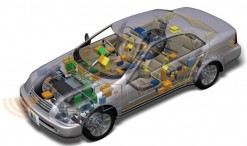Changes in the Automotive Industry and Their Impact on Electronics, Part 2
Today I’m returning to the topic of increased electronics complexity
in motor vehicles, with a specific focus on modular design. Last week we looked at maintaining reliability.
Importance of modular design. Gone are the days when automatic windows and door locks were a luxury optional extra. Now the add-ons are features such as navigation and Bluetooth are making modularized design a key factor in the design process.

Let me illustrate this further.As a result designers have to work together to consider how to optimize the addition of all the new features, while still maintaining the physical space reservation designated for each section of the automobile. (See FIGURE 1, right, 3D visualization assists with space reservation for modular design.)
Think of a stereo and speaker unit that may come as standard with a car, and the elective upgrade package that may include a rear camera or color display that manages your MP3 and voice control functions. Both the base feature and elective option must be allowed in the same space reservation allocated in the car. Which means you need to be thinking about this early in the design process to avoid costly mistakes (See FIGURE 2, below, modular design of multiple printed circuit boards concurrently in 3D.)
Power distribution. The power supply systems in a vehicle are already complex, and the electronics function of these add-ons is not the only concern – the car still needs to start every time and use the battery in the most efficient way.
That is why some car models have the option to upgrade to specific features and others don’t. If you try to add an after-market device to your car, the warranty may become void because manufacturers cannot guarantee that the existing power distribution can support the power consumption of new devices. As engineers address these types of issues during the design process, identifying the proper specifications of acceptable modules becomes vital to ensure the automobile operates correctly. In addition, it is important to understand which options, modules or after-market parts will violate operation specifications, in order to protect manufacturers from warranty disputes.
Design reuse. This is a well-applied concept within the automotive industry that enables teams to leverage design reuse from one model to another. As long as space reservation and reliability concerns are addressed, most modules can be reused effectively to allow manufacturers to deliver new products to the market on time. 
The vast network of suppliers and partners all work together during all facets of product development, from engineering to production. As each player in the process leverages reuse, the cost savings benefits quickly mount up – helping automotive manufacturers retain a competitive edge, and allowing suppliers to hold their ground as partners by providing cost-efficient solutions to the overall vehicle production process. The trick here is really to do this in the most effective way possible to maintain your competitive edge.
Next week I’ll bring you the final blog post in this series that looks at aligning data management to the design process and optimizing the complete electromechanical design.
HUMAIR MANDAVIA is executive director of the Zuken SOZO Center (zuken.com); This email address is being protected from spambots. You need JavaScript enabled to view it..




